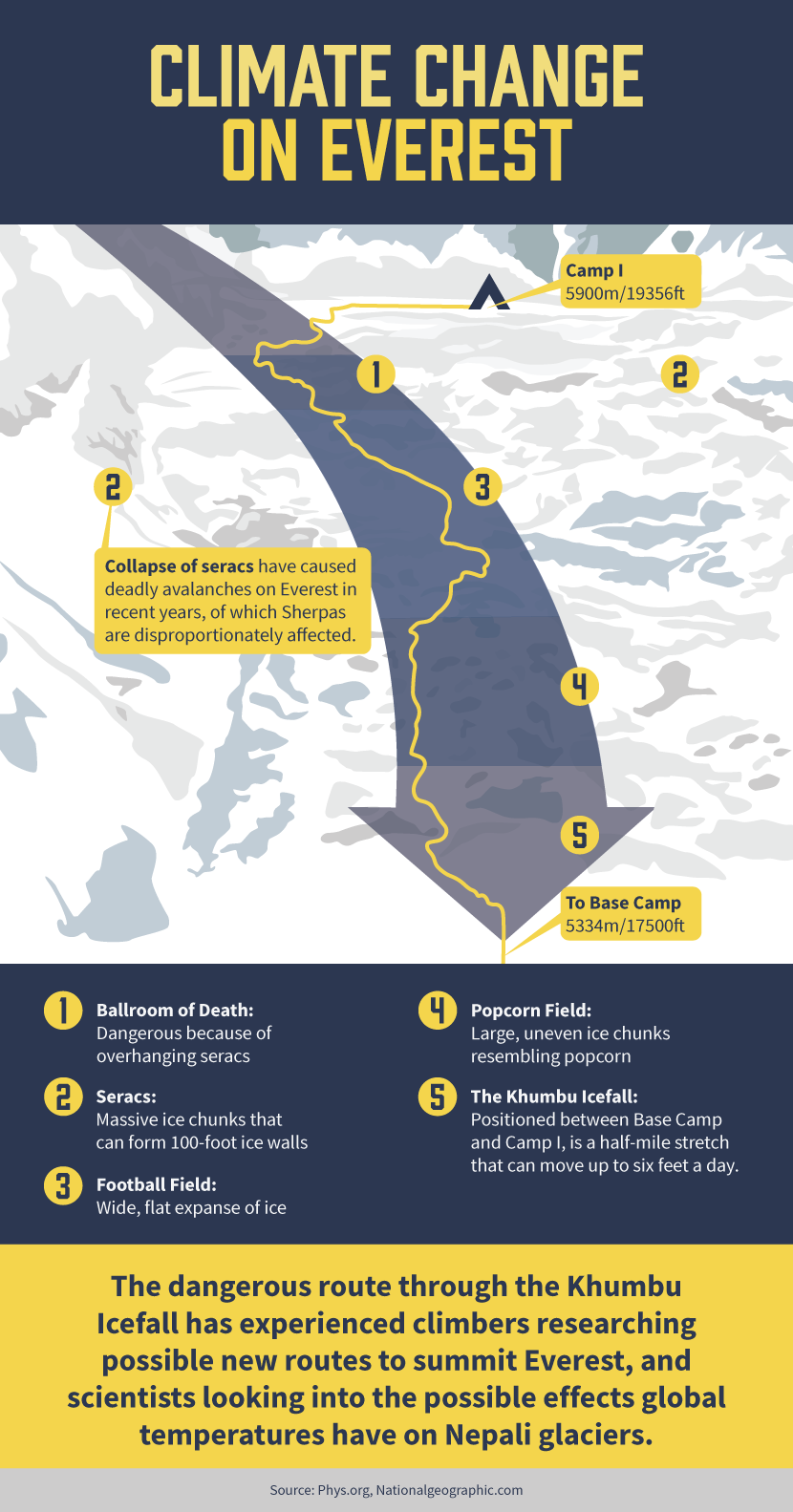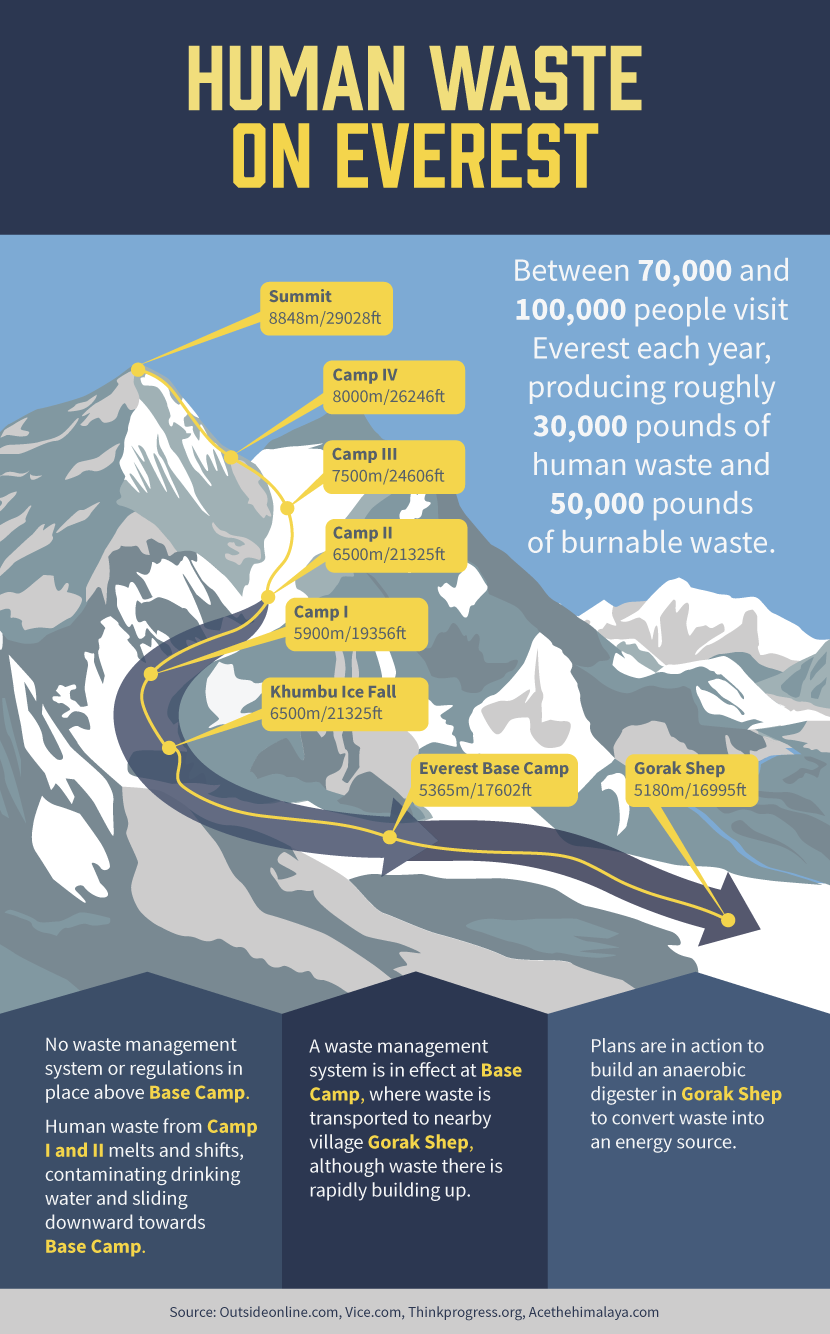Changes on Everest
The Effects of Climate Change and Lack of Waste Management
Mount Everest is often viewed in a vacuum. People see the world’s tallest mountain as a unique entity, rather than a single location in a struggling country.
To understand what happens on Everest and the problems associated with its popularity, it’s vital to consider the country of Nepal as a whole.
This is also the key to ensuring a future for the mountain and the people who rely on it for their living.
Infrastructure
Immediately after the 7.8-magnitude earthquake rocked Nepal in the spring of 2015, I learned what it means to have infrastructure. As aftershocks rattled the buildings, I ran into the city street and stood among cars and people, unsure of where to go.
A member of the Nepal Army stood beside me. I got his attention. I wanted him to tell me what to do, where to go to be safe. Instead, he looked as stunned and as scared as the hundreds of other residents screaming in the street.
In a country where the most famous feature, the Himalayas, is the direct result of violent earthquakes, the government of Nepal had few plans for reacting to this predictable disaster. This is what it means to have no infrastructure.

Nepal is a third-world country with a corrupt and inefficient government.http://kathmandupost.ekantipur.com/news/2016-01-27/nepal-slips-further-in-corruption-ranking.html The city of Kathmandu has open sewer lines and experiences scheduled power outages that last anywhere from a few hours to 18 hours.http://www.outsideonline.com/1969601/what-spcc-and-why-does-it-control-route-through-icefall
There are so many parts of the country that need resources, but Everest gets highlighted because it’s a popular destination.
This was especially apparent after last year’s earthquake, when much of the international attention focused on Everest and the deaths at its base camp. While 22 people died in the avalanche at Everest Base Camp, which was caused by the earthquake,
more than 10,000 Nepalis died nationwide.http://www.bbc.com/news/world-south-asia-12511455
Many of these deaths were in remote villages that are unfamiliar to foreigners and, therefore, received less international coverage and less international aid.
Everest Base Camp
Every year in early March, the first Sherpas arrive at the southern (Nepali) base of Mount Everest, about an hour’s walk from the nearest permanent settlement of Gorak Shep, to establish Everest Base Camp.
Because it’s located on glacier, the base camp has to be rebuilt each spring; the movement of the glacier buckles the previous year’s flat spots and redistributes the many rocks that were used to create tent platforms and team kitchens.
It takes about a month for expedition workers to build their teams’ camps.
The challenging trek to base camp appeals to many international tourists who have no interest in summiting the mountain; simply arriving at base camp, at an elevation of 17,600 feet, is an achievement in and of itself.http://www.alanarnette.com/blog/2015/02/13/everest-2015-permit-status/
History
Nepal kept its borders closed to foreigners until 1951, largely out of fears about colonialism, which had a large impact on its neighbors, Tibet and India.http://www.bbc.com/news/world-south-asia-12511455
Two years later, Tenzing Norgay and Sir Edmund Hillary completed the first successful climb of Mount Everest. In the six decades since the country began welcoming tourists and the mountain’s summit became attainable,
Everest’s popularity has grown exponentially. In 2014, nearly 250 people purchased permits for an attempt on Everest.http://www.alanarnette.com/blog/2015/02/13/everest-2015-permit-status/ However, the number of people traveling to Everest each year is much higher:
it includes thousands of tourists trekking to base camp, hundreds of local guides traveling to the area to support expeditions, and countless porters carrying gear to and from the temporary community at the base of the mountain.http://www.outsideonline.com/1969601/what-spcc-and-why-does-it-control-route-through-icefall
While this growth has been sharp, it is also somewhat predictable. An array of developments – including technological advances, increased international mobility, and the consistency of the route – make Everest’s summit attainable to a wider range of people.
However, the government’s policies regarding tourism are primarily reactionary.
This has caused serious problems for the region, especially with regard to garbage.

Permit Money
Tourism is the third-largest contributor to the Nepali economy after exports and international aid.http://www.bbc.com/news/world-south-asia-12511455 Mountaineering permits are one way the government of Nepal has monetized the popularity of Everest and the country’s other tall peaks.
In 2015, the cost for a permit to climb Everest was $11,000 USD.http://www.alanarnette.com/blog/2015/02/13/everest-2015-permit-status/ Despite this influx of mountaineering money, the infrastructure and resources for popular regions like the Khumbu are almost as scarce as they have always been.
Many international visitors have picked up responsibilities in areas the government is lacking.http://www.outsideonline.com/1969601/what-spcc-and-why-does-it-control-route-through-icefall
Impact
Crowds on Everest have had a number of negative impacts, ranging from an increased amount of refuse on the mountain to an elevated risk to climbers, who can get caught in dangerous logjams of people.
The amount of waste created by climbing expeditions in Nepal is staggering: an estimated 30,000 pounds of human waste and 50,000 pounds of burnable waste per year.http://www.outsideonline.com/1969601/what-spcc-and-why-does-it-control-route-through-icefall
The impact is noticeable: candy bar wrappers, plastic water bottles, and other non-biodegradable trash are common on trails. Less visible, but no less impactful, is the quality of the water.
Although much of the water in the Khumbu comes from glaciers, human waste is so prevalent that all of the water must be treated or boiled before it’s consumed.
This is to say nothing of the trash on Everest itself, which includes used oxygen bottles, discarded gear, and human remains.
In an attempt to clean up both the region and its image, the Nepali government has made sweeping promises about trash removal on Everest and in the surrounding areas.http://www.outsideonline.com/1969601/what-spcc-and-why-does-it-control-route-through-icefall
A dirty Everest could mean fewer climbers and fewer tourists, which is an incentive for the government. However, removing waste is complicated and expensive.
Sagarmatha National Park, which is home to Everest and falls within the Khumbu region, contains a number of villages where the only resources that arrive and leave are brought by yaks, human porters, or the rare (and costly) arrival of a helicopter.
Burning waste is common, but burning plastics contributes to the deterioration of glaciers and is unpopular with Western tourists.http://www.alanarnette.com/blog/2015/02/13/everest-2015-permit-status/
Some expeditions have committed to removing waste from the mountain and the government has led efforts to build trash cans along the popular treks, both of which have helped ease the stress.http://www.outsideonline.com/1969601/what-spcc-and-why-does-it-control-route-through-icefall
However, it doesn’t solve the bigger issue of where the trash goes when it leaves the region.
Kathmandu has its own waste management issues and there is no question that simply moving the waste around the country will not fix the country’s larger problems surrounding infrastructure and economic stability.

Future
Nepal is a most unique and welcoming place. Every person I met was kind and gracious; I was a frequent guest of perfect strangers.
This is the reason so much money came pouring into the country last spring after the earthquake; people who visit Nepal are connected to the country and its people for the rest of their lives.
The country will continue to attract mountaineers and curious tourists who will fall in love with Nepal; with the right information, these future visitors will understand the role they play in a complex economy and culture.
Embed the article on your site

